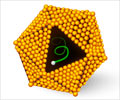Researchers have devised a novel viral culture system, which makes way for a better study of Hepatitis C virus
Researchers have devised a novel viral culture system, which makes way for a better study of Hepatitis C virus. This system enables the replication of virus (isolated from patient) in non-transformed hepatocytes. Systems in vogue involve culture of permissive viral strains in transformed cell lines.
The study report by Lázaro et al, ‘Hepatitis C virus replication in transfected and serum-infected cultured human fetal hepatocytes,’ appears in the February issue of The American Journal of Pathology.Hepatitis C virus (HCV) infection affects approximately 170,000,000 people worldwide. HCV liver disease, which may induce liver inflammation, cirrhosis, and/or hepatocellular carcinoma, represents the foremost reason for liver transplantation in much of the U.S.
Study of HCV replication within liver cells, or hepatocytes, has been hampered by a lack of adequate virus culture systems. Some systems allow the virus to infect cells but do not permit prolonged replication and production of virus, while other systems rely on derivatives of permissive virus isolates for efficient replication in transformed (mutated) cell lines. Still lacking has been a system to sustain replication of novel virus isolates from patients using non- transformed hepatocytes.
Nelson Fausto of the University of Washington School of Medicine has crossed this hurdle using a human fetal hepatocyte culture system that was previously developed in his lab. Using this system, his group has demonstrated sustained replication and production of virus particles for at least 2 months; these virus particles are able to infect new cells.
In their first experiments, Fausto and colleagues transfected hepatocyte cultures with HCV genomic RNA and found replication of HCV RNA genomes and production of core protein (for virus particle formation). Release of infectious virus particles was confirmed, as media from these cells were able to infect naive hepatocytes. Finally, virus particles were examined by electron microscopy and shown to possess the expected size and shape of HCV virus particles.
Once the system was established, the group examined whether sera from patients carrying HCV could infect the human fetal hepatocytes. When sera from patients infected with different HCV strains were added to the hepatocyte culture system, viral replication occurred and new virus particles were produced.
Advertisement
This culture system provides a breakthrough in studying HCV replication in non-transformed hepatocytes, the natural target of the virus. By allowing infection by patient serum containing a wide array of virus strains, this system may allow better understanding of the differences between different strains, further improving treatment strategies.
Advertisement
PRI/S











